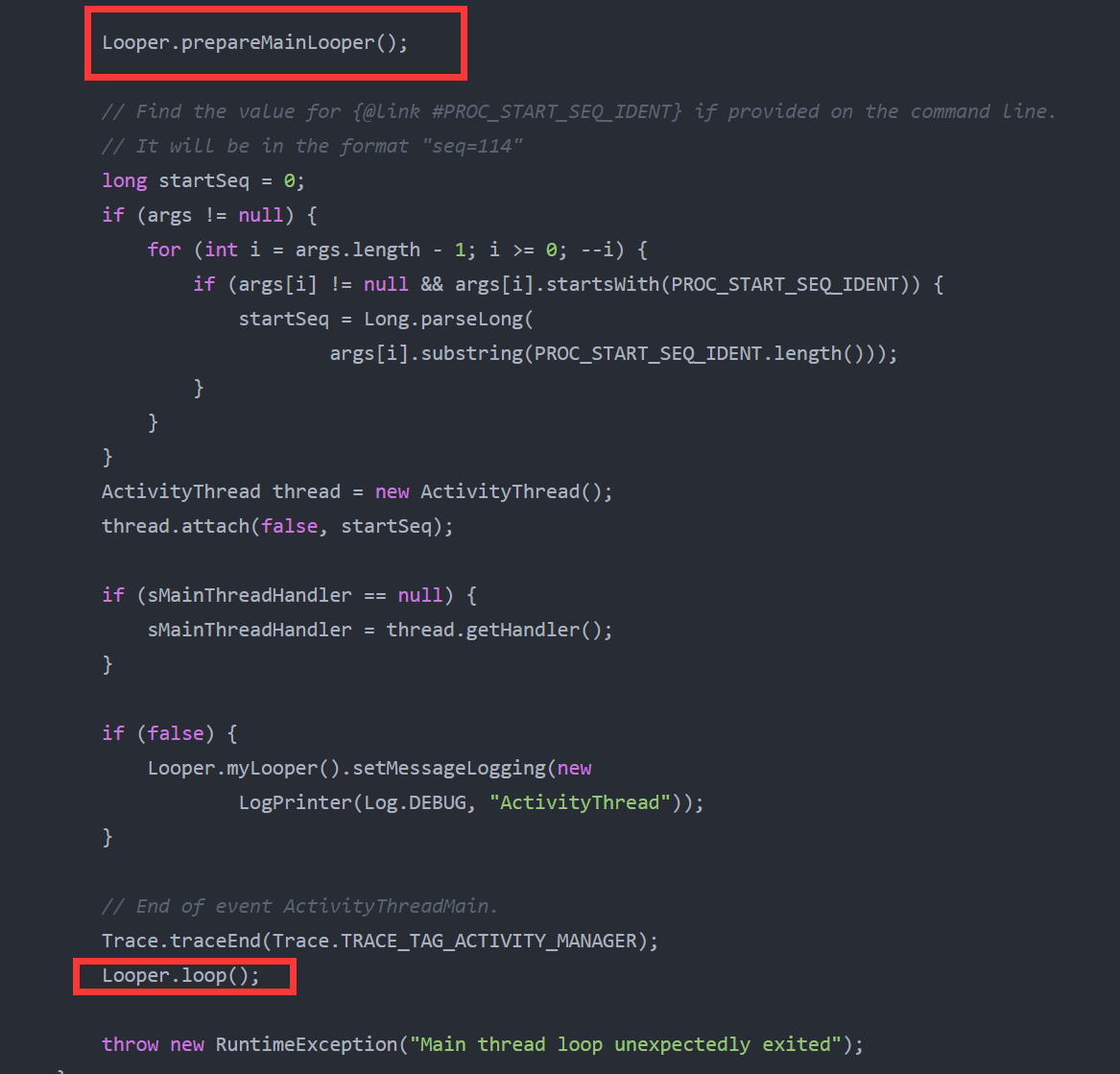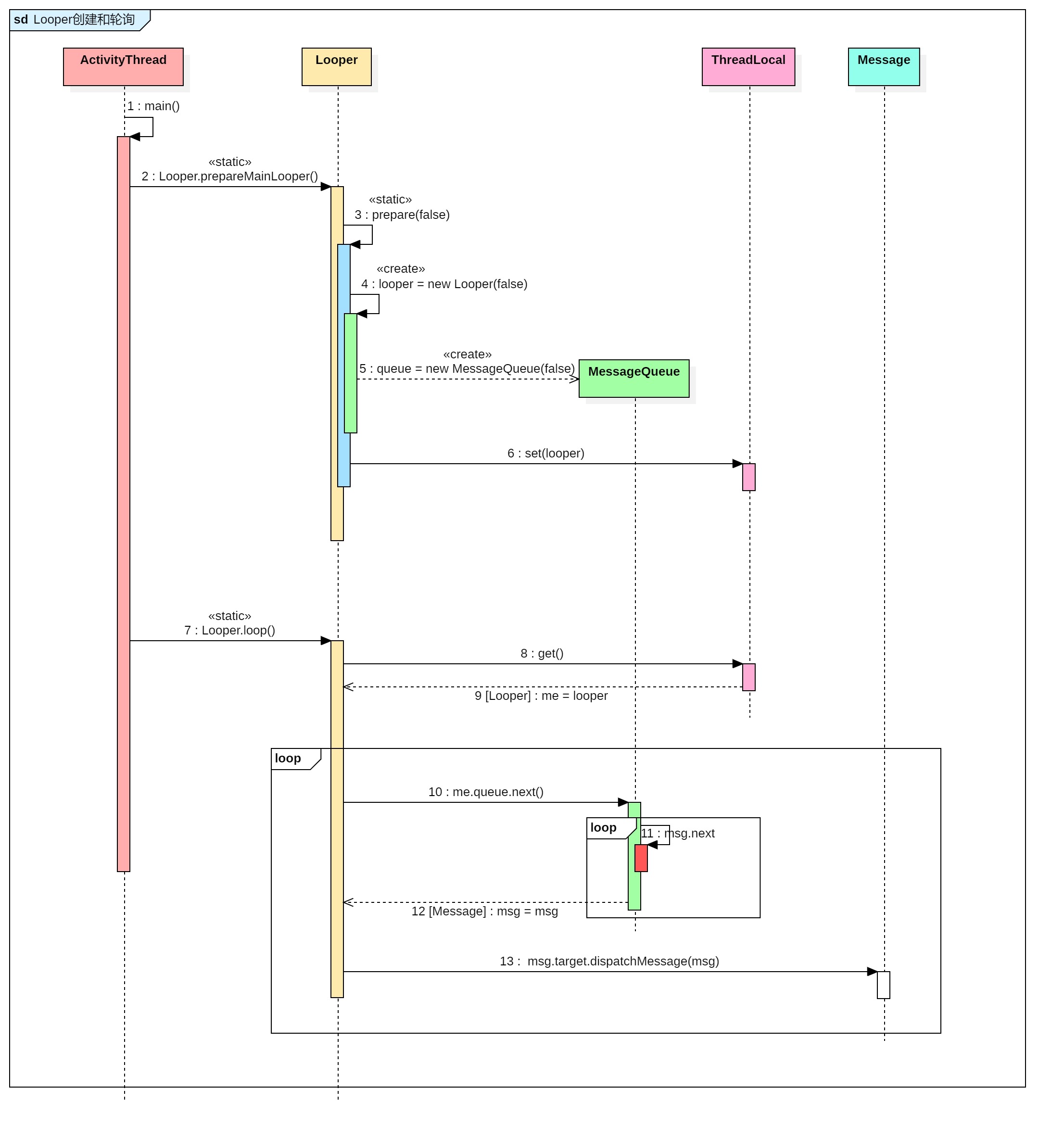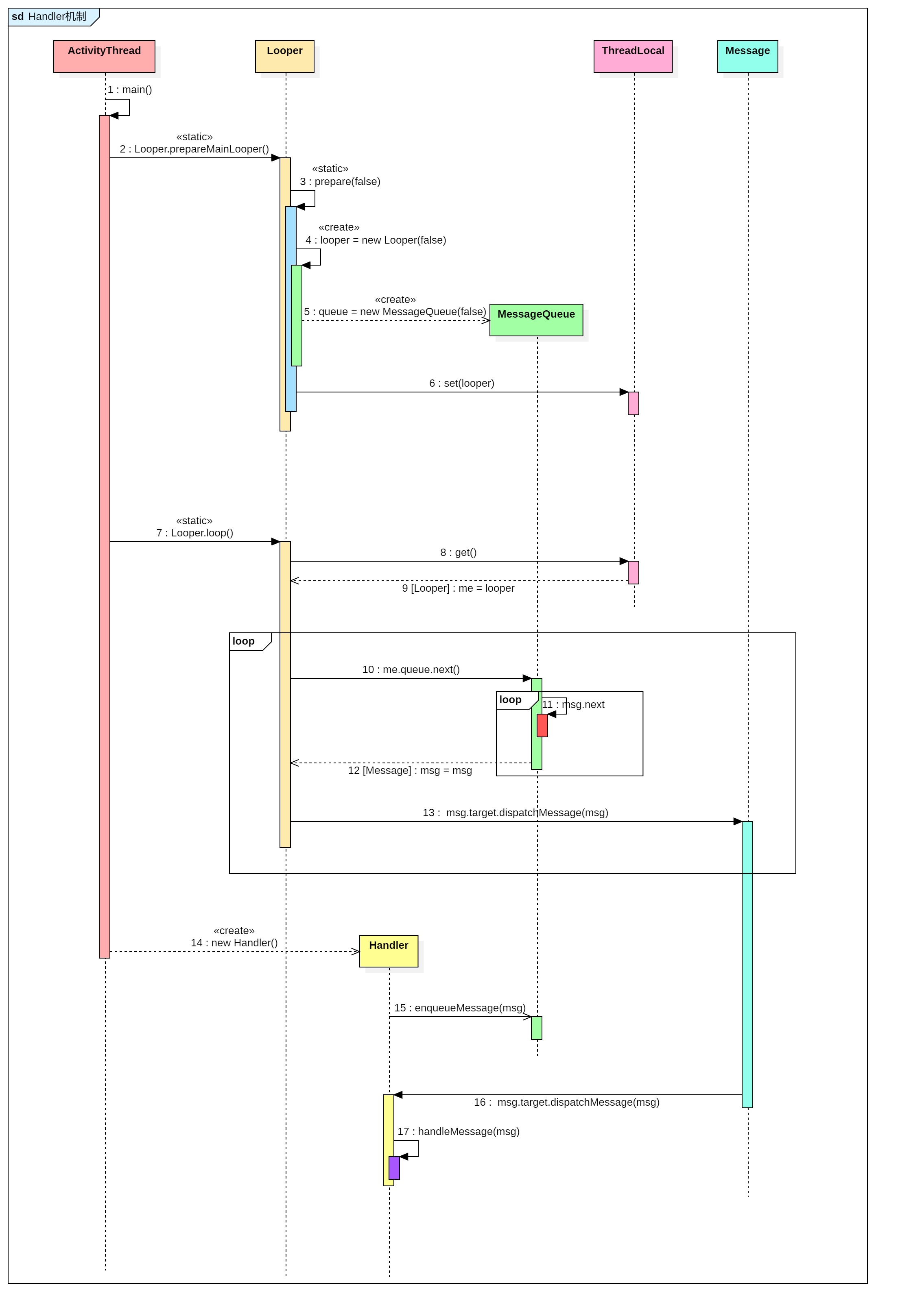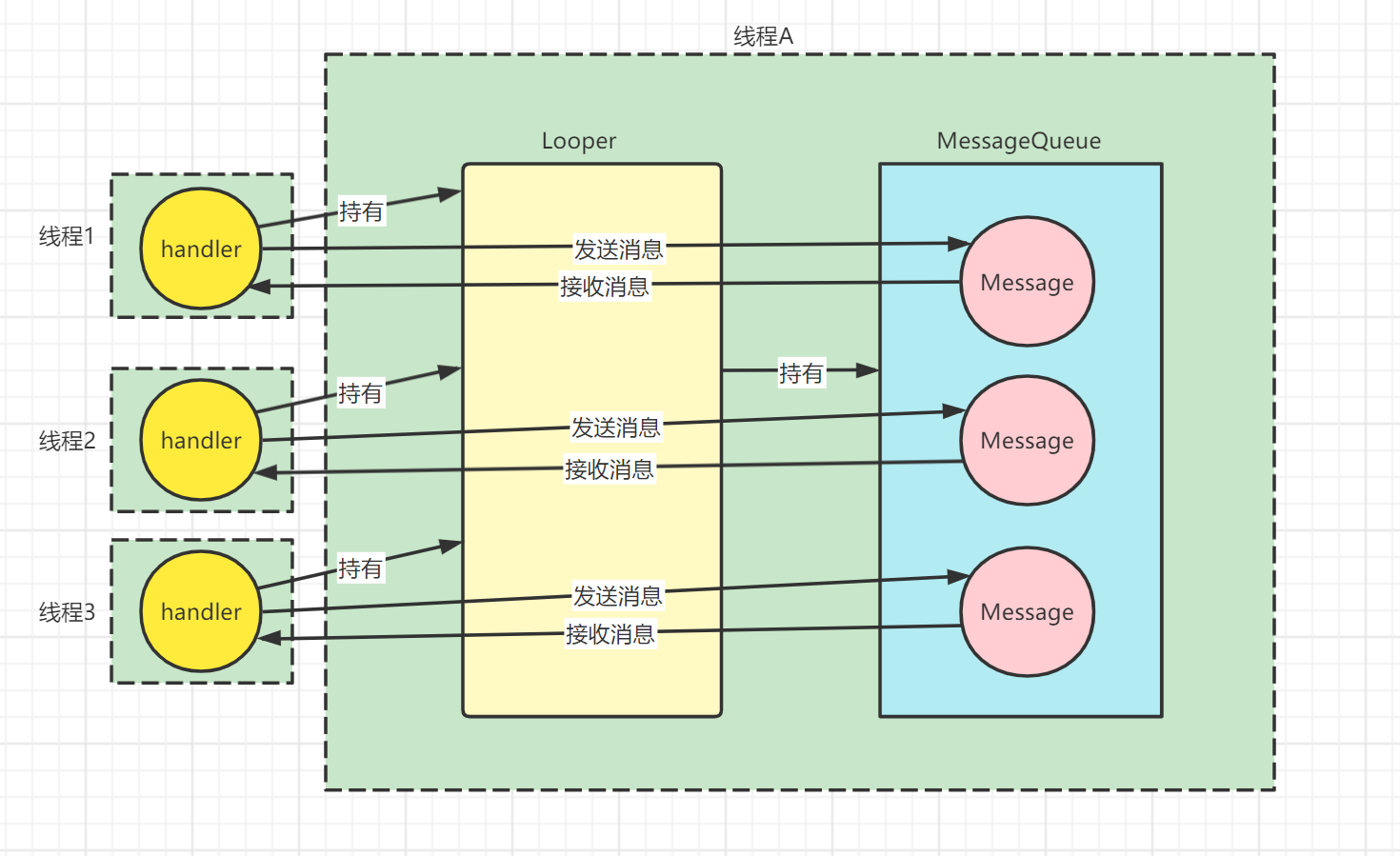说到Handler,绝大多数人都知道,它就是一个死循环,不断的遍历消息队列,通过handler将消息入队,循环中有消息就取出来消费掉,以实现线程间的通信。
说个题外话,记得有一次面试,面试官问我线程间怎么通信?我当时就很疑惑,线程间本来就是资源共享的,谈何怎么通信,调用线程的方法或者改变线程的变量值就可以实现通信了,只不过需要自己做一些线程同步的处理。对我们来说,Hanlder机制只是安卓SDK封装了一个线程通信的工具罢了,它通过生产者消费者模式处理了多线程同步,当然了它封装的功能很强大
网上关于Handler的源码分析已经有很多了,自己看了源码后,也想做个总结,今天利用时序图和流程图来做一个简单分析,尽量使用简洁易懂的方式来帮助理解
一、Handler源码分析
1.Looper创建及启动轮询
Java程序的入口为main函数,每个App都是一个单独的Java程序,App启动流程涉及到底层dalvik/art虚拟机的fork进程,跨进程通信等,暂不深入探究。如果想要程序一直运行,那么main函数不能结束执行,还记得之前的Java--线程文章么,对于底层OS而言,main函数是一个进程也是线程,也就是我们常说的主线程
安卓中主线程的入口位于ActivityThread类中的main函数,代码如下,过下即可:
public static void main(String[] args) {
Trace.traceBegin(Trace.TRACE_TAG_ACTIVITY_MANAGER, "ActivityThreadMain");
// Install selective syscall interception
AndroidOs.install();
// CloseGuard defaults to true and can be quite spammy. We
// disable it here, but selectively enable it later (via
// StrictMode) on debug builds, but using DropBox, not logs.
CloseGuard.setEnabled(false);
Environment.initForCurrentUser();
// Make sure TrustedCertificateStore looks in the right place for CA certificates
final File configDir = Environment.getUserConfigDirectory(UserHandle.myUserId());
TrustedCertificateStore.setDefaultUserDirectory(configDir);
// Call per-process mainline module initialization.
initializeMainlineModules();
Process.setArgV0("<pre-initialized>");
Looper.prepareMainLooper();
// Find the value for {@link #PROC_START_SEQ_IDENT} if provided on the command line.
// It will be in the format "seq=114"
long startSeq = 0;
if (args != null) {
for (int i = args.length - 1; i >= 0; --i) {
if (args[i] != null && args[i].startsWith(PROC_START_SEQ_IDENT)) {
startSeq = Long.parseLong(
args[i].substring(PROC_START_SEQ_IDENT.length()));
}
}
}
ActivityThread thread = new ActivityThread();
thread.attach(false, startSeq);
if (sMainThreadHandler == null) {
sMainThreadHandler = thread.getHandler();
}
if (false) {
Looper.myLooper().setMessageLogging(new
LogPrinter(Log.DEBUG, "ActivityThread"));
}
// End of event ActivityThreadMain.
Trace.traceEnd(Trace.TRACE_TAG_ACTIVITY_MANAGER);
Looper.loop();
throw new RuntimeException("Main thread loop unexpectedly exited");
}main函数中,我们需要关心的只有下面的两个方法:

1.1 Looper.prepareMainLooper方法
main函数中调用Looper.prepareMainLooper方法,做了一些初始化操作:
public static void prepareMainLooper() {
//初始化操作
prepare(false);
...
}prepareMainLooper方法又调用了prepare方法,其中比较核心的是使用ThreadLocal,保存当前线程的Looper,并在Looper的私有构造方法中,实例化了消息队列:
static final ThreadLocal<Looper> sThreadLocal = new ThreadLocal<Looper>();
private static void prepare(boolean quitAllowed) {
//如果一个线程中调用两次prepare,抛出异常
if (sThreadLocal.get() != null) {
throw new RuntimeException("Only one Looper may be created per thread");
}
//将Looper存入ThreadLocal
sThreadLocal.set(new Looper(quitAllowed));
}
private Looper(boolean quitAllowed) {
mQueue = new MessageQueue(quitAllowed);
mThread = Thread.currentThread();
}关于ThreadLocal,Looper中方法基本都是静态的,ThreadLocal对象也是静态的,静态对象本该是线程间共享的,但ThreadLocal内部对线程进行了区分,其set方法可以根据当前线程来存放当前线程的私有工作内存,相应的get方法是获取当前线程存放的私有工作内存,这里相当于将线程和Looper进行了一对一关系的绑定,以便在线程中调用获取当前线程的Looper
我们通过Looper.myLooper方法就可以获取到调用该方法时运行的线程的Looper,主要提供给Looper的loop方法和Handler的空构造方法使用,后续分析中可以看到该方法的调用:
public static @Nullable Looper myLooper() {
return sThreadLocal.get();
}1.1 Looper.loop方法
为了使main函数一直执行,Looper.loop方法会一直轮询,我们查看它的具体代码实现,由于代码太多,我做了简化:
public static void loop() {
//获取当前线程的Looper
final Looper me = myLooper();
...
final MessageQueue queue = me.mQueue;
...
for (;;) {
//阻塞获取Message
Message msg = queue.next(); // might block
if (msg == null) {
// No message indicates that the message queue is quitting.
return;
}
...
try {
//分发消息
msg.target.dispatchMessage(msg);
...
} catch (Exception exception) {
...
throw exception;
} finally {
...
}
...
}
}其中queue为MessageQueue对象,即调用了MessageQueue的next方法,next方法的实现也是个轮询,一旦MessageQueue中有消息了并且没有延迟执行,那么返回该队列头的Message给Looper:
//类似链表的头节点
Message mMessages;
Message next() {
...
// 轮询获取Message
for (;;) {
...
synchronized (this) {
...
Message prevMsg = null;
Message msg = mMessages;
...
if (msg != null) {
if (now < msg.when) {
// Next message is not ready. Set a timeout to wake up when it is ready.
nextPollTimeoutMillis = (int) Math.min(msg.when - now, Integer.MAX_VALUE);
} else {
// Got a message.
mBlocked = false;
if (prevMsg != null) {
prevMsg.next = msg.next;
} else {
mMessages = msg.next;
}
msg.next = null;
if (DEBUG) Log.v(TAG, "Returning message: " + msg);
msg.markInUse();
// 获取到后,将Message返回
return msg;
}
} else {
// No more messages.
nextPollTimeoutMillis = -1;
}
// Looper准备退出了
// Process the quit message now that all pending messages have been handled.
if (mQuitting) {
dispose();
return null;
}
....
}
...
}
}Looper.loop方法中的msg.target.dispatchMessage(msg)我们回头再来看
1.3 Looper创建和轮询的时序图
如果你对上面的流程还有不清楚的地方,可以配合时序图来方便理解,或者直接看时序图

流程总结:
1.主线程调用Looper.prepareMainLooper(),最终实例化了Looper对象,构造时又实例化了成员变量MessageQueue,并使用ThreadLocal将Looper和当前线程绑定
2.主线程调用Looper.loop()方法,从ThreadLocal中获取当前线程的Looper,开启轮询,不断从MessageQueue获取Message,获取后调用 msg.target.dispatchMessage(msg),往复轮询操作
2.Handler发送消息与接收消息
我们常常会在Activity中定义一个Handler成员变量(实际上不推荐直接new Handler(),容易内存泄漏),并重写handleMessage方法来接收消息,接下来分析Handler源码
2.1 Handler空构造
空构造函数如下,Activity中是主线程,所以 Looper.myLooper()返回的就是主线程创建的Looper:
@Deprecated
public Handler() {
this(null, false);
}
public Handler(@Nullable Callback callback, boolean async) {
if (FIND_POTENTIAL_LEAKS) {
final Class<? extends Handler> klass = getClass();
if ((klass.isAnonymousClass() || klass.isMemberClass() || klass.isLocalClass()) &&
(klass.getModifiers() & Modifier.STATIC) == 0) {
Log.w(TAG, "The following Handler class should be static or leaks might occur: " +
klass.getCanonicalName());
}
}
mLooper = Looper.myLooper();
if (mLooper == null) {
throw new RuntimeException(
"Can't create handler inside thread " + Thread.currentThread()
+ " that has not called Looper.prepare()");
}
mQueue = mLooper.mQueue;
mCallback = callback;
mAsynchronous = async;
}2.2 消息入队
MessageQueue也是主线程的消息队列,当别的线程操作这个handler时,就可以把消息往这个MessageQueue中入队,而主线程Looper在不断的轮询这个消息队列
Handler的sendMessage方法的调用链如下:
public final boolean sendMessage(@NonNull Message msg) {
return sendMessageDelayed(msg, 0);
}
public final boolean sendMessageDelayed(@NonNull Message msg, long delayMillis) {
if (delayMillis < 0) {
delayMillis = 0;
}
return sendMessageAtTime(msg, SystemClock.uptimeMillis() + delayMillis);
}
public boolean sendMessageAtTime(@NonNull Message msg, long uptimeMillis) {
MessageQueue queue = mQueue;
if (queue == null) {
RuntimeException e = new RuntimeException(
this + " sendMessageAtTime() called with no mQueue");
Log.w("Looper", e.getMessage(), e);
return false;
}
return enqueueMessage(queue, msg, uptimeMillis);
}我们重点关注enqueueMessage方法,其中将Message的target设置成了当前Handler自己,最后将该msg入队MessageQueue :
private boolean enqueueMessage(@NonNull MessageQueue queue, @NonNull Message msg,
long uptimeMillis) {
//将target设置为当前Handler
msg.target = this;
msg.workSourceUid = ThreadLocalWorkSource.getUid();
if (mAsynchronous) {
msg.setAsynchronous(true);
}
return queue.enqueueMessage(msg, uptimeMillis);
}至此,就和Looper.loop方法关联起来了,Looper.loop方法最终调用了 msg.target.dispatchMessage(msg),就是调用了Handler的dispatchMessage方法
2.3 Handler dispatchMessage方法handleMessage方法
dispatchMessage方法只是做了转发,最终调用了handleMessage方法,而我们正是重写了该方法
public void dispatchMessage(@NonNull Message msg) {
if (msg.callback != null) {
handleCallback(msg);
} else {
if (mCallback != null) {
if (mCallback.handleMessage(msg)) {
return;
}
}
handleMessage(msg);
}
}2.4 Handler发送消息与接收消息时序图
在上面的时序图中,增加Handler发送和接收消息,有些调用链就简略掉了:

我们目前只争对主线程进行了分析,但不难理解的是, Handler机制除了主线程外,也可以作为其他线程消息通信的工具,只需要在其他的线程中实例化新的Looper,并且创建对应Looper的Handler就可以实现非主线程的消息通信,十分便利。这套架构的精髓是handler即作为被观察者,又作为观察者

二、手写Handler机制
有了上面的基础后,简单的手写一个Handler机制
1.定义Message类
/**
* Created by aruba on 2021/11/13.
*/
class Message implements Comparable<Message> {
public int what;
public Object msg;
protected Handler target;
public int when;
public Message() {
}
public Message(int what, Object msg) {
this.what = what;
this.msg = msg;
}
@Override
public int compareTo(Message message) {
return when - message.when - 1;
}
}2.定义Looper
import java.util.PriorityQueue;
/**
* Created by aruba on 2021/11/13.
*/
public class Looper {
PriorityQueue<Message> messageQueue;
static ThreadLocal<Looper> mThreadLocal = new ThreadLocal<>();
boolean quited = false;
private Looper() {
messageQueue = new PriorityQueue<>();
}
/**
* 实例化当前线程Looper
*/
public synchronized static void prepare() {
if (mThreadLocal.get() != null) throw new RuntimeException("looper has created");
mThreadLocal.set(new Looper());
}
/**
* 线程轮询
*/
public static void loop() {
//获取当前线程的looper
Looper looper = mThreadLocal.get();
if (looper == null) throw new RuntimeException("looper has not created");
PriorityQueue<Message> queue = looper.messageQueue;
while (true) {
synchronized (looper) {
Message top = queue.poll();
if (top != null) {//调用handler的handleMessage方法
top.target.handleMessage(top);
}
}
if (looper.quited) {//退出
break;
}
}
}
/**
* 消息入队
*
* @param msg
*/
public synchronized void enqueueMessage(Message msg) {
messageQueue.offer(msg);
}
public void quite() {
quited = true;
mThreadLocal.remove();
}
}3.定义Handler
/**
* Created by aruba on 2021/11/13.
*/
public class Handler {
final Looper mLooper;
public Handler(Looper mLooper) {
this.mLooper = mLooper;
}
public Handler() {
mLooper = Looper.mThreadLocal.get();
}
public void enqueueMessage(Message msg) {
msg.target = this;
synchronized (mLooper) {
mLooper.enqueueMessage(msg);
}
}
public void handleMessage(Message msg) {
}
}4.测试方法:
public class TestHanlder {
public static void main(String[] args) {
Looper.prepare();
final Handler handler = new Handler() {
@Override
public void handleMessage(Message msg) {
super.handleMessage(msg);
System.out.println("what:" + msg.what + " msg:" + msg.msg);
}
};
new Thread(new Runnable() {
@Override
public void run() {
for (int i = 0; i < 10; i++) {
handler.enqueueMessage(new Message(i, "hello"));
}
}
}).start();
Looper.loop();
}
}结果:
what:0 msg:hello
what:1 msg:hello
what:2 msg:hello
what:3 msg:hello
what:4 msg:hello
what:5 msg:hello
what:6 msg:hello
what:7 msg:hello
what:8 msg:hello
what:9 msg:hello
Process finished with exit code -1